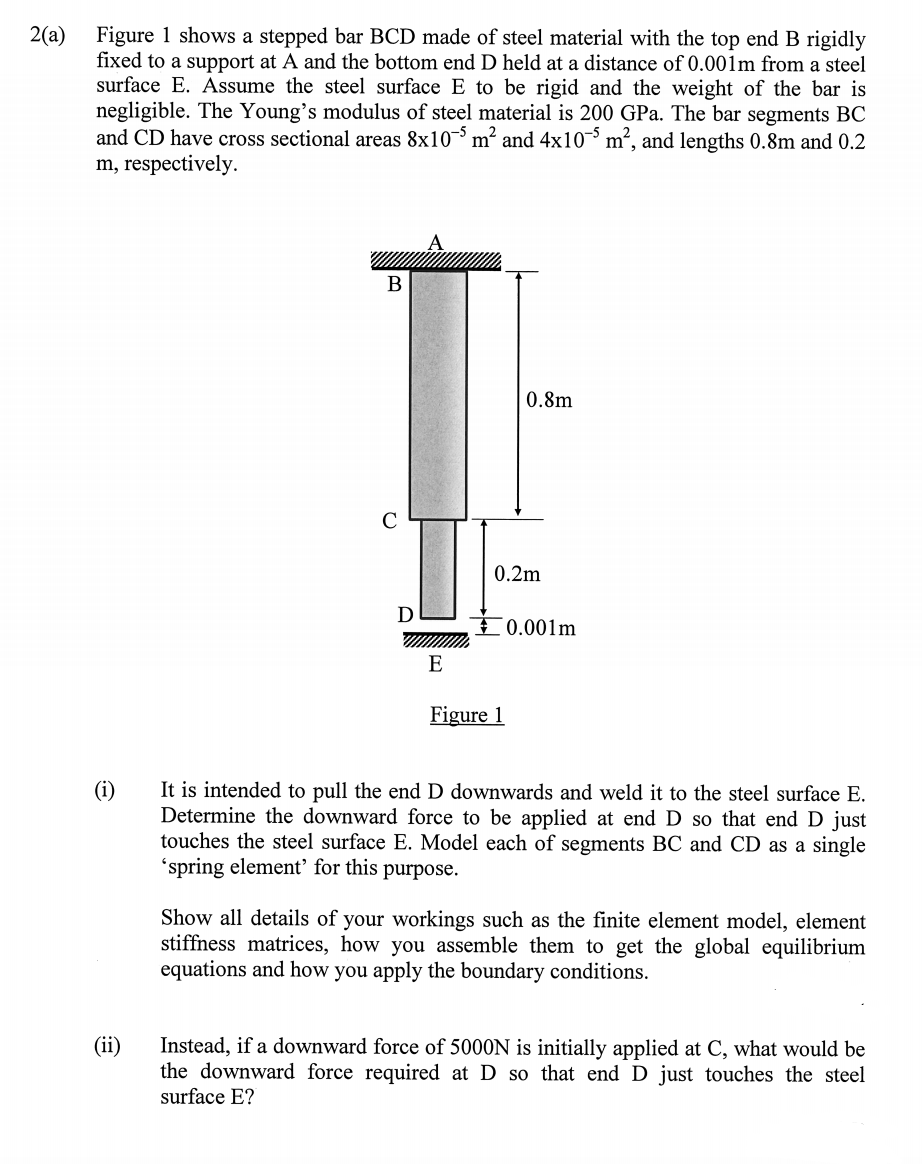Figure 1 shows a stepped bar BCD made of steel material with the top end B rigidly fixed to a support at A and the bottom end D held at a distance of 0.001m from a steel surface E. Assume the steel surface E to be rigid and the weight of the bar is negligible. The Young's modulus of steel material is 200 GPa. The bar segments BC and CD have cross sectional areas 8x10¯³ m² and 4x10 m², and lengths 0.8m and 0.2 m, respectively. 0.8m 0.2m I 0.001m E Figure 1 It is intended to pull the end D downwards and weld it to the steel surface E. Determine the downward force to be applied at end D so that end D just touches the steel surface E. Model each of segments BC and CD as a single 'spring element’ for this purpose. (i) Show all details of your workings such as the finite element model, element stiffness matrices, how you assemble them to get the global equilibrium equations and how you apply the boundary conditions. Instead, if a downward force of 5000N is initially applied at C, what would be the downward force required at D so that end D just touches the steel surface E? (ii)
Figure 1 shows a stepped bar BCD made of steel material with the top end B rigidly fixed to a support at A and the bottom end D held at a distance of 0.001m from a steel surface E. Assume the steel surface E to be rigid and the weight of the bar is negligible. The Young's modulus of steel material is 200 GPa. The bar segments BC and CD have cross sectional areas 8x10¯³ m² and 4x10 m², and lengths 0.8m and 0.2 m, respectively. 0.8m 0.2m I 0.001m E Figure 1 It is intended to pull the end D downwards and weld it to the steel surface E. Determine the downward force to be applied at end D so that end D just touches the steel surface E. Model each of segments BC and CD as a single 'spring element’ for this purpose. (i) Show all details of your workings such as the finite element model, element stiffness matrices, how you assemble them to get the global equilibrium equations and how you apply the boundary conditions. Instead, if a downward force of 5000N is initially applied at C, what would be the downward force required at D so that end D just touches the steel surface E? (ii)
Mechanics of Materials (MindTap Course List)
9th Edition
ISBN:9781337093347
Author:Barry J. Goodno, James M. Gere
Publisher:Barry J. Goodno, James M. Gere
Chapter2: Axially Loaded Members
Section: Chapter Questions
Problem 2.3.2P: A long, rectangular copper bar under a tensile load P hangs from a pin that is supported by two...
Related questions
Question

Transcribed Image Text:2(a)
Figure 1 shows a stepped bar BCD made of steel material with the top end B rigidly
fixed to a support at A and the bottom end D held at a distance of 0.001m from a steel
surface E. Assume the steel surface E to be rigid and the weight of the bar is
negligible. The Young's modulus of steel material is 200 GPa. The bar segments BC
and CD have cross sectional areas 8x10 m² and 4x10¯³ m², and lengths 0.8m and 0.2
m, respectively.
В
0.8m
C
0.2m
D
I0.001m
E
Figure 1
It is intended to pull the end D downwards and weld it to the steel surface E.
Determine the downward force to be applied at end D so that end D just
touches the steel surface E. Model each of segments BC and CD as a single
'spring element for this purpose.
(i)
Show all details of your workings such as the finite element model, element
stiffness matrices, how you assemble them to get the global equilibrium
equations and how you apply the boundary conditions.
(ii)
Instead, if a downward force of 5000N is initially applied at C, what would be
the downward force required at D so that end D just touches the steel
surface E?
Expert Solution
This question has been solved!
Explore an expertly crafted, step-by-step solution for a thorough understanding of key concepts.
Step by step
Solved in 2 steps

Knowledge Booster
Learn more about
Need a deep-dive on the concept behind this application? Look no further. Learn more about this topic, mechanical-engineering and related others by exploring similar questions and additional content below.Recommended textbooks for you

Mechanics of Materials (MindTap Course List)
Mechanical Engineering
ISBN:
9781337093347
Author:
Barry J. Goodno, James M. Gere
Publisher:
Cengage Learning

Mechanics of Materials (MindTap Course List)
Mechanical Engineering
ISBN:
9781337093347
Author:
Barry J. Goodno, James M. Gere
Publisher:
Cengage Learning